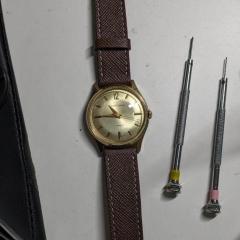Opening a Poljot de Luxe 23 jewel case (2209 movement)
-
Similar Content
-
Recently Browsing
- No registered users viewing this page.
-
Topics
-
Posts
-
Amazing 🙂 I am very happy to hear this. I shall keep my eyes open for some red threadlock to go on sale and pick up a little tube. Thank you all for your assistance and wonderful first exposure to this site and community!
-
Just a reminder we have a section just for these sort of things. https://www.watchrepairtalk.com/forum/74-new-to-watch-repair-safe-zone-for-learner-watch-repairers/ When reassembling a watch as others have pointed out it's wise to check the functionality of components as you go. So in other words before the pallet fork goes in or even the balance wheel you can attempt to wind the watch and make sure the gear train spins nicely. Then you can put the pallet fork in wind up the power and see that the pallet fork snaps each time you push it back and forth in other words things need to be done in steps not all assembled and then discover we have a problem. Although unfortunately sometimes that does happen and sometimes the problems do not show up instantaneously.
-
Now One of the things that's always helpful when asking for help for any watch would be which watch exactly are we talking about? Because the definition of small pocket watch doesn't exactly do it for us. Do we have a name of who made the movement and typically that's not the name on the dial. I find your quote really quite fascinating? Lacking knowledge of the movement is quite a hindrance in this discussion. Then there are companies that make balance completes for replacing in watches. No need to try to order from the manufacturer as that isn't going to happen anyway. Then I think it would be helpful to clarify something? You're helping the charity shop I'm understanding at the extreme the lowest price to achieve what goal? So in other words all you have to do is get the watch to run for a few seconds a few minutes long enough to sell it and clear it out and make a profit correct? What I'm getting at here is were going to throw conventional watch repair practices out the window and go with whatever we need to do which means you could just Glue with whatever you have. It's not the recommended procedure but I'm interpreting were not using the recommended procedures we want to do fast quick repairs I get these things out the door correct?
-
That does look promising to be repairable without having to start threading and tapping things.
-
To be honest I never use calipers when bending a balance bridge as I'm checking the end shake as I do it a little at a time. Now that you've bent your bridge how Has it changed your end shake?
-






Recommended Posts